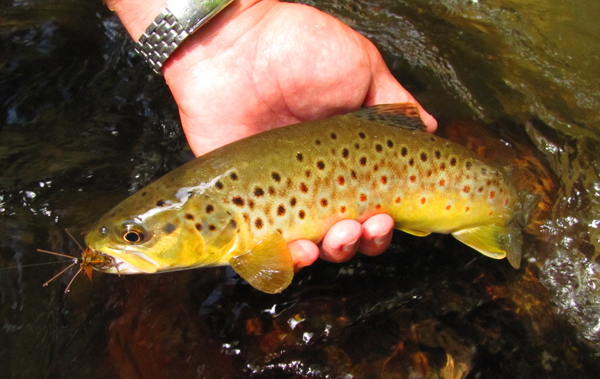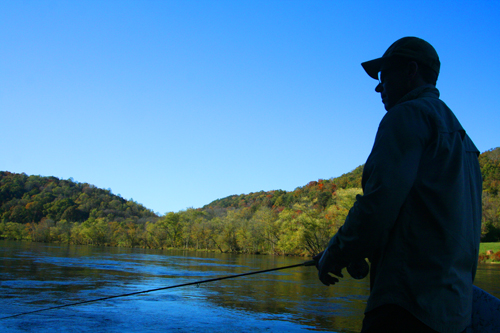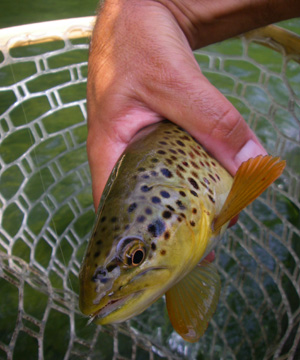High water became a bit of a regular thing around here and after nice weekend in the Smokies it’s pretty obvious that most anglers have all bit given up on fishing. You can tell because there were very few fishermen out on the river. Fortunately it looks like we’ve turned the corner and water conditions are anywhere from good to, well, still pretty bad. We’ll lay it all out….
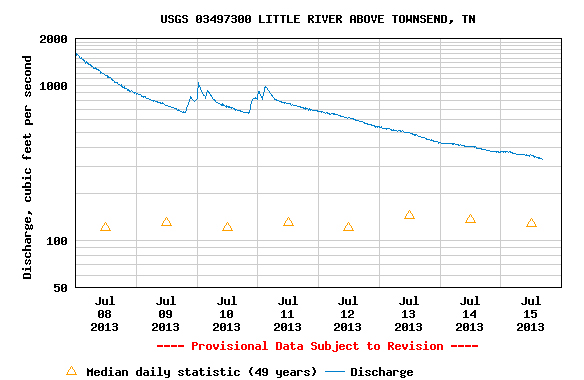
Water in the Smokies is still a little on the high side but currently fishable getting back to normal
The Smokies
Right now the Smokies are in about as good a shape as they’ve been all season long. Water levels have receded across the mountains and the streams are fishing. The water levels we’re seeing now are what we’d expect in April. That means they’r fishable, just higher than what we expect in the middle of summer. Many we’ve talked to are thinking more about high elevation streams to beat the high water, but that’s not the course of action we’d recommend.
Most of the high elevation streams are also high gradient. That means that they’re steep and full of white water. While these streams are the usual choice for temporary high water conditions in the Smokies we’d recommend you give them a few more days. They always clear out first after thunderstorms, but the heavy precipitation we experienced this season has been widespread and these streams are just about as high as everything else. The steep nature of these streams makes them a bit touchy with this much water. If the weather holds we expect the high elevation brook trout streams to be great in about a week.
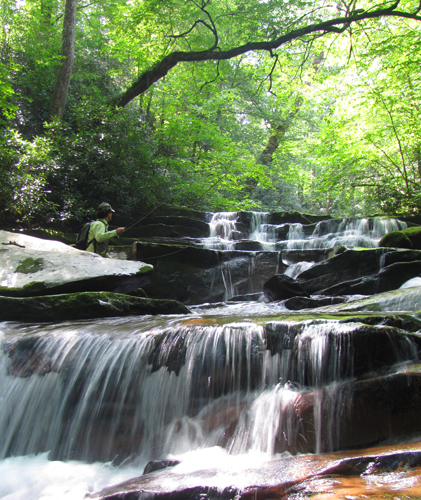
This is a typical flow. Multiply this flow by about three and imagine trying to get around. Not pretty…
On the positive side you’ll find the larger streams fishing quite well. Nymphs are the best bet for the most hook ups, but don’t feel like you need to be fanatical about it. Fish are rising and bushy dries are doing much better than they usually do in mid-summer. Our pick is a #16 Copper John or Tellico Nymph fished about 24″ underneath a #12 Stimulator.
Want to really swing for the fences? These water conditions are perfect for fishing a Rubber Leg Tellico Nymph as Golden Stoneflies are hatching. These are always a staple in the diet of larger trout.
Here’s something else to keep in mind. The Cataloochee area of the Smokies didn’t seem to receive as much rain as the rest of the park. These streams are little ahead of the others in terms of being closer to normal. This can also be said for the Tellico basin south of the Smokies. North River and Bald River along with other Tellico River tributaries will feel much closer to what normal feels like in July.
The Tailwaters
Right now the tailwaters are a mixed bag. Some are fishing pretty good and others are still way too high. Here’s the river by river break down. If you’re a wader you might consider looking back at the information concerning the Smokies or skip straight to the parts about the South Holston or Hiwassee.
Clinch River – The Clinch is pushing every last drop that TVA can generate, over 9,000 cfs. That’s pretty impressive since it rarely pushes out more than 7,000 cfs. In all likelihood TVA might even want to be sluicing right now, but there’s so much water in the Tennessee River system already they can still draw Norris Lake down without putting any extra burden on downstream reservoirs.
If you have a boat and just can’t stand it you could probably turn some nice fish with large streamers and a heavy sink tip line fished on a 6-8 weight fly rod. This isn’t for the faint of heart and is rarely ultra productive. However, when you do hook a fish there’s always a chance for that fish of a lifetime since the Clinch has a robust population of trout over five pounds and some large stripers in the mix as well.
Holston River below Cherokee Dam – We’re not expecting to cast at trout here until late autumn at best. The lake is relatively high and the water coming out of the dam is much warmer than usual. The store of cold water was blown out and replaced with warmer water that’s not so cold. Water temps aren’t lethal for the trout right now, but at this rate we don’t want to see the water off for very long as we’re entering the hottest part of the year. If the water is coming out of the dam in the 60’s it can warm up really fast on a 95 degree day if flows are at a minimum. Fortunately it doesn’t look like we’ll see minimum flows for a long time.
South Holston – The South Holston is the one bright shining jewel among the tailwaters right now. Flows are great and there’s even some space for waders to find time on the water. The bad news is that since it’s almost the only game around it’s even more crowded than usual. We heard a report last week that somewhere around 30 boats put in at the upper ramp one day last week. Dry fly fishing is good though with Sulphurs hatching reliably.
Watauga River – The Watauga is usually the most consistent river as far as good flows are concerned, but this year the only consistency is with high water. Watauga Lake is at record high levels and TVA is moving the water out as fast as they can through the dam and Wilbur Lake below. Wilbur Dam is sluicing over 3,000 cfs so most anglers won’t recognize the river as they usually find it flowing somewhere around 250 cfs most of the time. However, there are some good reports from those who are floating the river. We just wouldn’t recommend that anyone who hasn’t been on the river or has marginal skills on a set of oars give it a try.
Hiwassee River – If there’s a river that’s stood to benefit from all this rain it’s the Hiwassee. Dry years can take a toll on the Hiwassee and the drought years from 2007-08 were particularly hard here. It was made even worse since its headwaters in Georgia were experiencing drought conditions for a couple of years before that. By all accounts this is the best year the river has seen in some time. It’s wide, shallow nature doesn’t blow it out as quickly as other rivers so local guides have done well there floating it around 5,000 cfs when it rarely ever reaches 3,000 cfs. Dry fly fishing has been excellent with good Isonychia hatches.
Wading fishermen can find some water to fish on the Hiwassee, but honestly, it’s not for the meek. Areas across the suspension bridge downstream of the powerhouse have some good opportunities along the banks. Those with rafts or inflatable catamaran style craft can access numerous areas to wade in the middle of the river.
As always, wear a PFD on this river and we never recommend anyone float it in a drift boat until they’ve been down it with someone who knows the routes. It’s very easy to find yourself down a dead end and wreck a boat here. Of all the rivers in the United States, the name Hiwassee probably comes to mind quickest for the guys who repair boats for Hyde and Clackacraft.
Smallmouth Bass
Let’s not forget the smallies! This is usually when topwater fishing is at its peak and we’re consumed with thoughts of popping bugs going under in a swirl. There are plenty of good opportunities for smallmouth this summer, but you might have to adjust your usual routine.
The Holston and French Broad Rivers near Knoxville are essentially blown out right now because of high flows from the dams. Upstream closer to Kingsport the Holston should be fishing okay. The French Broad around Asheville…. Think high and muddy, but it can improve up there after a short dry spell.
Those who like to chase the small jaws from a boat should remember the Pigeon River. High water makes this an easier river to float and it’s consistently rated as one of the top rivers in the state. Not sure? Just notice how many North Carolina license plates there are along the river and you’ll see how some anglers are willing to travel here.
Our advice is to think about the freestone bass rivers that you may have ignored for a long time. Little River and Tellico River are two that come to mind first. Little River is still running a little high for wading right now but should come along nicely before long. It’s actually in great shape to float right now.
Tellico River upstream of Tellico Plains has long been ignored because it’s too warm for trout, but it’s a haven for red eyes and smallmouth. Even better, it’s incredibly scenic and all the other fishermen (fly or bait) are upstream chasing trout.
